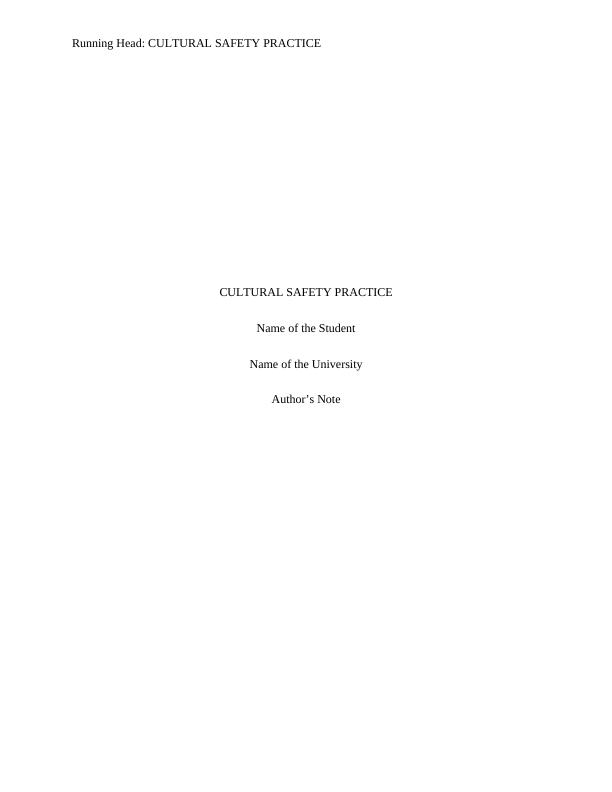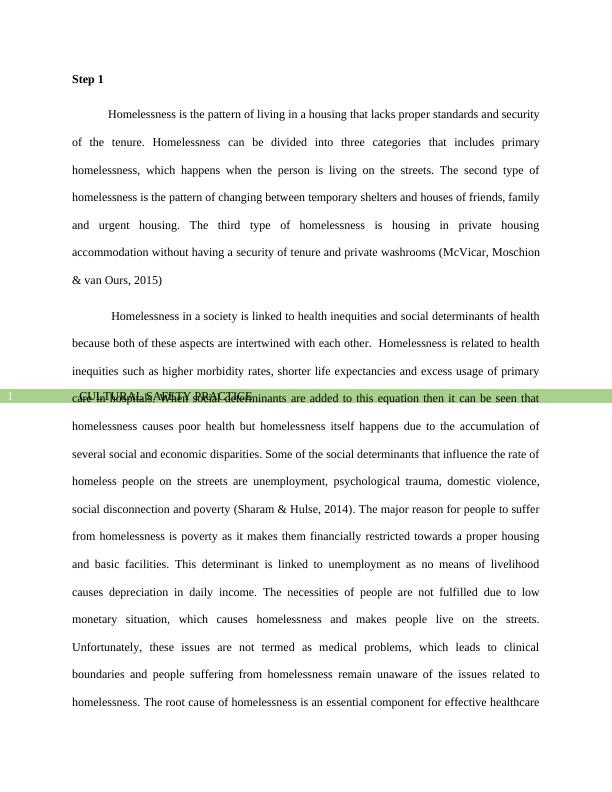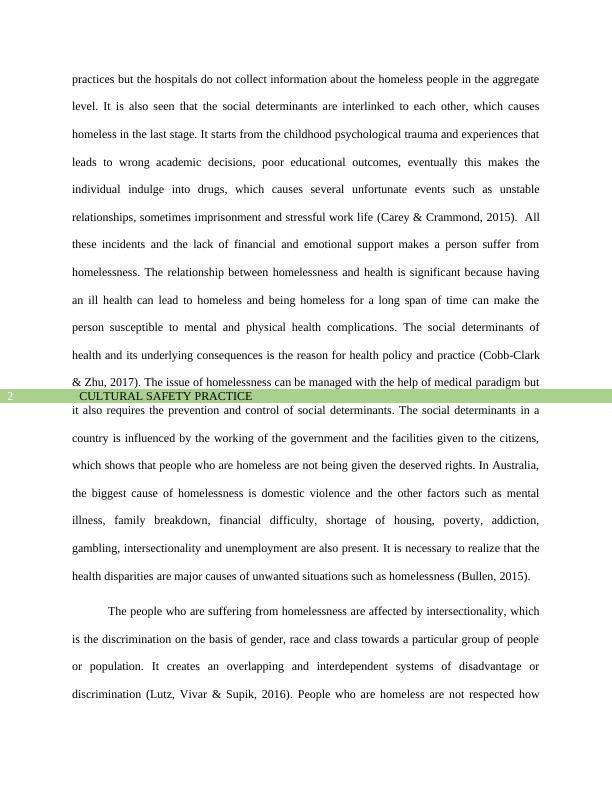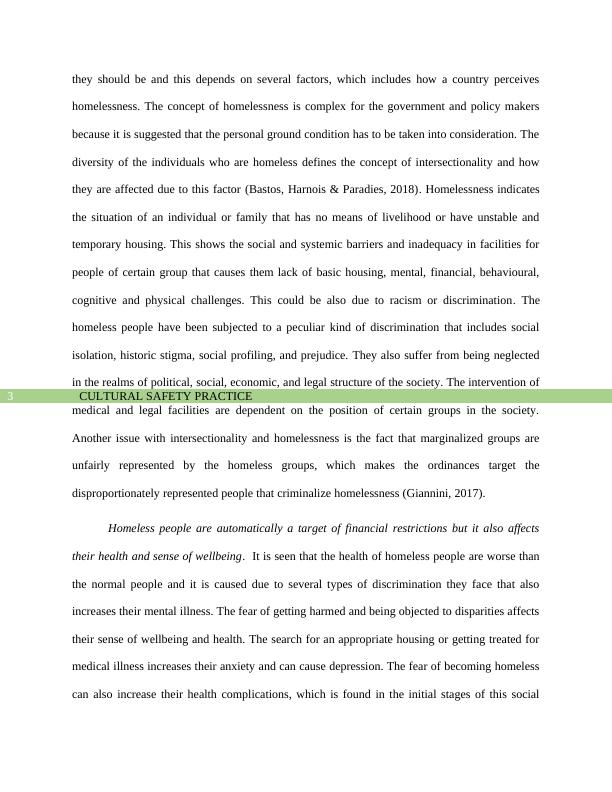The cultural safety practice
Added on 2022-09-13
14 Pages3673 Words10 Views
Running Head: CULTURAL SAFETY PRACTICE
CULTURAL SAFETY PRACTICE
Name of the Student
Name of the University
Author’s Note
CULTURAL SAFETY PRACTICE
Name of the Student
Name of the University
Author’s Note

CULTURAL SAFETY PRACTICE1
Step 1
Homelessness is the pattern of living in a housing that lacks proper standards and security
of the tenure. Homelessness can be divided into three categories that includes primary
homelessness, which happens when the person is living on the streets. The second type of
homelessness is the pattern of changing between temporary shelters and houses of friends, family
and urgent housing. The third type of homelessness is housing in private housing
accommodation without having a security of tenure and private washrooms (McVicar, Moschion
& van Ours, 2015)
Homelessness in a society is linked to health inequities and social determinants of health
because both of these aspects are intertwined with each other. Homelessness is related to health
inequities such as higher morbidity rates, shorter life expectancies and excess usage of primary
care in hospitals. When social determinants are added to this equation then it can be seen that
homelessness causes poor health but homelessness itself happens due to the accumulation of
several social and economic disparities. Some of the social determinants that influence the rate of
homeless people on the streets are unemployment, psychological trauma, domestic violence,
social disconnection and poverty (Sharam & Hulse, 2014). The major reason for people to suffer
from homelessness is poverty as it makes them financially restricted towards a proper housing
and basic facilities. This determinant is linked to unemployment as no means of livelihood
causes depreciation in daily income. The necessities of people are not fulfilled due to low
monetary situation, which causes homelessness and makes people live on the streets.
Unfortunately, these issues are not termed as medical problems, which leads to clinical
boundaries and people suffering from homelessness remain unaware of the issues related to
homelessness. The root cause of homelessness is an essential component for effective healthcare
Step 1
Homelessness is the pattern of living in a housing that lacks proper standards and security
of the tenure. Homelessness can be divided into three categories that includes primary
homelessness, which happens when the person is living on the streets. The second type of
homelessness is the pattern of changing between temporary shelters and houses of friends, family
and urgent housing. The third type of homelessness is housing in private housing
accommodation without having a security of tenure and private washrooms (McVicar, Moschion
& van Ours, 2015)
Homelessness in a society is linked to health inequities and social determinants of health
because both of these aspects are intertwined with each other. Homelessness is related to health
inequities such as higher morbidity rates, shorter life expectancies and excess usage of primary
care in hospitals. When social determinants are added to this equation then it can be seen that
homelessness causes poor health but homelessness itself happens due to the accumulation of
several social and economic disparities. Some of the social determinants that influence the rate of
homeless people on the streets are unemployment, psychological trauma, domestic violence,
social disconnection and poverty (Sharam & Hulse, 2014). The major reason for people to suffer
from homelessness is poverty as it makes them financially restricted towards a proper housing
and basic facilities. This determinant is linked to unemployment as no means of livelihood
causes depreciation in daily income. The necessities of people are not fulfilled due to low
monetary situation, which causes homelessness and makes people live on the streets.
Unfortunately, these issues are not termed as medical problems, which leads to clinical
boundaries and people suffering from homelessness remain unaware of the issues related to
homelessness. The root cause of homelessness is an essential component for effective healthcare

CULTURAL SAFETY PRACTICE2
practices but the hospitals do not collect information about the homeless people in the aggregate
level. It is also seen that the social determinants are interlinked to each other, which causes
homeless in the last stage. It starts from the childhood psychological trauma and experiences that
leads to wrong academic decisions, poor educational outcomes, eventually this makes the
individual indulge into drugs, which causes several unfortunate events such as unstable
relationships, sometimes imprisonment and stressful work life (Carey & Crammond, 2015). All
these incidents and the lack of financial and emotional support makes a person suffer from
homelessness. The relationship between homelessness and health is significant because having
an ill health can lead to homeless and being homeless for a long span of time can make the
person susceptible to mental and physical health complications. The social determinants of
health and its underlying consequences is the reason for health policy and practice (Cobb-Clark
& Zhu, 2017). The issue of homelessness can be managed with the help of medical paradigm but
it also requires the prevention and control of social determinants. The social determinants in a
country is influenced by the working of the government and the facilities given to the citizens,
which shows that people who are homeless are not being given the deserved rights. In Australia,
the biggest cause of homelessness is domestic violence and the other factors such as mental
illness, family breakdown, financial difficulty, shortage of housing, poverty, addiction,
gambling, intersectionality and unemployment are also present. It is necessary to realize that the
health disparities are major causes of unwanted situations such as homelessness (Bullen, 2015).
The people who are suffering from homelessness are affected by intersectionality, which
is the discrimination on the basis of gender, race and class towards a particular group of people
or population. It creates an overlapping and interdependent systems of disadvantage or
discrimination (Lutz, Vivar & Supik, 2016). People who are homeless are not respected how
practices but the hospitals do not collect information about the homeless people in the aggregate
level. It is also seen that the social determinants are interlinked to each other, which causes
homeless in the last stage. It starts from the childhood psychological trauma and experiences that
leads to wrong academic decisions, poor educational outcomes, eventually this makes the
individual indulge into drugs, which causes several unfortunate events such as unstable
relationships, sometimes imprisonment and stressful work life (Carey & Crammond, 2015). All
these incidents and the lack of financial and emotional support makes a person suffer from
homelessness. The relationship between homelessness and health is significant because having
an ill health can lead to homeless and being homeless for a long span of time can make the
person susceptible to mental and physical health complications. The social determinants of
health and its underlying consequences is the reason for health policy and practice (Cobb-Clark
& Zhu, 2017). The issue of homelessness can be managed with the help of medical paradigm but
it also requires the prevention and control of social determinants. The social determinants in a
country is influenced by the working of the government and the facilities given to the citizens,
which shows that people who are homeless are not being given the deserved rights. In Australia,
the biggest cause of homelessness is domestic violence and the other factors such as mental
illness, family breakdown, financial difficulty, shortage of housing, poverty, addiction,
gambling, intersectionality and unemployment are also present. It is necessary to realize that the
health disparities are major causes of unwanted situations such as homelessness (Bullen, 2015).
The people who are suffering from homelessness are affected by intersectionality, which
is the discrimination on the basis of gender, race and class towards a particular group of people
or population. It creates an overlapping and interdependent systems of disadvantage or
discrimination (Lutz, Vivar & Supik, 2016). People who are homeless are not respected how

CULTURAL SAFETY PRACTICE3
they should be and this depends on several factors, which includes how a country perceives
homelessness. The concept of homelessness is complex for the government and policy makers
because it is suggested that the personal ground condition has to be taken into consideration. The
diversity of the individuals who are homeless defines the concept of intersectionality and how
they are affected due to this factor (Bastos, Harnois & Paradies, 2018). Homelessness indicates
the situation of an individual or family that has no means of livelihood or have unstable and
temporary housing. This shows the social and systemic barriers and inadequacy in facilities for
people of certain group that causes them lack of basic housing, mental, financial, behavioural,
cognitive and physical challenges. This could be also due to racism or discrimination. The
homeless people have been subjected to a peculiar kind of discrimination that includes social
isolation, historic stigma, social profiling, and prejudice. They also suffer from being neglected
in the realms of political, social, economic, and legal structure of the society. The intervention of
medical and legal facilities are dependent on the position of certain groups in the society.
Another issue with intersectionality and homelessness is the fact that marginalized groups are
unfairly represented by the homeless groups, which makes the ordinances target the
disproportionately represented people that criminalize homelessness (Giannini, 2017).
Homeless people are automatically a target of financial restrictions but it also affects
their health and sense of wellbeing. It is seen that the health of homeless people are worse than
the normal people and it is caused due to several types of discrimination they face that also
increases their mental illness. The fear of getting harmed and being objected to disparities affects
their sense of wellbeing and health. The search for an appropriate housing or getting treated for
medical illness increases their anxiety and can cause depression. The fear of becoming homeless
can also increase their health complications, which is found in the initial stages of this social
they should be and this depends on several factors, which includes how a country perceives
homelessness. The concept of homelessness is complex for the government and policy makers
because it is suggested that the personal ground condition has to be taken into consideration. The
diversity of the individuals who are homeless defines the concept of intersectionality and how
they are affected due to this factor (Bastos, Harnois & Paradies, 2018). Homelessness indicates
the situation of an individual or family that has no means of livelihood or have unstable and
temporary housing. This shows the social and systemic barriers and inadequacy in facilities for
people of certain group that causes them lack of basic housing, mental, financial, behavioural,
cognitive and physical challenges. This could be also due to racism or discrimination. The
homeless people have been subjected to a peculiar kind of discrimination that includes social
isolation, historic stigma, social profiling, and prejudice. They also suffer from being neglected
in the realms of political, social, economic, and legal structure of the society. The intervention of
medical and legal facilities are dependent on the position of certain groups in the society.
Another issue with intersectionality and homelessness is the fact that marginalized groups are
unfairly represented by the homeless groups, which makes the ordinances target the
disproportionately represented people that criminalize homelessness (Giannini, 2017).
Homeless people are automatically a target of financial restrictions but it also affects
their health and sense of wellbeing. It is seen that the health of homeless people are worse than
the normal people and it is caused due to several types of discrimination they face that also
increases their mental illness. The fear of getting harmed and being objected to disparities affects
their sense of wellbeing and health. The search for an appropriate housing or getting treated for
medical illness increases their anxiety and can cause depression. The fear of becoming homeless
can also increase their health complications, which is found in the initial stages of this social

End of preview
Want to access all the pages? Upload your documents or become a member.
Related Documents
Are there homeless or poor people in South Korea?lg...
|15
|3315
|18
Investigation of Peer Support Workers for Homeless and Marginalized Peoplelg...
|15
|4445
|250
Homelessness problems Assignment PDFlg...
|14
|2570
|36
Social Determinants of Health - PDFlg...
|10
|2288
|280
Critical Healthcare Practice: Understanding the Link between Poverty and Indigenous Health in Australialg...
|4
|509
|116
Issues Prevailing In The Society | Report | Essaylg...
|13
|4923
|380